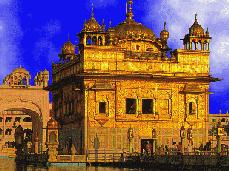
May You Be Blessed by the God of Your Heart |
The Geography of SikhismThe Essentials of the FaithFounded: The history of Sikhism began in 1469 with the birth of Guru Nanak in the present-day Indian state of Punjab. Submerged in an atmosphere of religious turmoil, Guru Nanak sought to bridge the gulf between Islam and Hinduism. He was followed by nine other Gurus, some adding unique contributions to the Sikh religion, until Guru Gobind Rai, the tenth and final Guru, invested his authority into the Sikh community on one the hand, and the collection of Sikh scripture, the Adi Granth, on the other (Eerdmans, p. 201). Adherents: Until the twentieth century, Sikhs were rarely found outside of the Punjab region. As they are increasingly being found throughout the world, they can be recognized by their distinctive dress, defined by the "Five K's", discussed below. Distribution: The distribution listed below for Sikhs is from Markham, pp. 356-357:
Major Teachings: The central teaching of Sikhism is the idea of the guru. God is the true and ultimate Guru which chose to speak to man through the ten historical gurus. The Sikh community is considered another guru, and the Sikh scriptures, also known as the Guru Granth Sahib is yet another. God provides enlightenment and can be experienced through worship and meditation. A Sikh's life is centered around devotion, community life, and keeping the high standards of behavior expected of every initiated Sikh (Eerdmans, pp. 197, 198). Scriptures and Significant Writings: As described above, the worldly deposition of all wisdom is found in the Guru Granth. It is a collection of poetry, hymns and devotional writing compiled from the historical gurus. The final compilation is called the Adi Granth, meaning the original or first book of scriptures. A collection of the hymns and poetry of the final historical guru, Guru Gobind Singh, is called the Dasam Granth (Eerdmans, pp. 201). The scriptures of other religions, such as the Koran or the Bhagavad Gita may be studied by the Sikh, but it is the Guru Granth which is the ultimate authority.
Major Divisions: Many Sikhs vary in their observance, but as a whole there are not many sects which have developed. The Mandharis and the Nirankaris have struggled historically with the idea of Guruship and believe that there is still a living Guru. Other minute sects do exist. Major Holy Days: The major Sikh holy days are Divali (festival of deliverance), Guru Nanak's birthday, the Martyrdom of Guru Tegh Bhadur, Guru Gobind Singh's birthday, Baisakhi (founding of the order of the Khalsa), and the Martyrdom of Guru Arjan Dev (Markham, p. 353).
The Details about SikhismGuru Nanak was born into a family of Hindus of the Brahmin caste, the highest caste within Hinduism. Nanak was very distinguished from birth and started questioning the ethics of Hinduism. One day he went to a stream to water his father's cattle and went into a deep trance lasting three days. Upon his return, Nanak claimed that he had come face to face with the Throne of the Supreme Being and was ordered by a formless god, Akal Purakh, to go about distributing his possessions to the poor and speaking the divine word. Guru Nanak did not preach against Hinduism nor Islam, but offered a variation of these beliefs which appealed to many.The title Guru is a teacher or leader and throughout Sikh history there have been ten Gurus. Nanak was the first Guru and he appointed his successor to be Angad. Next was Amar Das, who was followed by his son-in-law, Ram Das, the fourth Guru. Ram Das established the community of Amritsar, which became the major religious center of Sikhism as well as a major economic trading center of northern India. Argan, the son of Ram Das, became the fifth Guru and he was responsible for compiling the original editon of the Adi Granth. Arjan was killed by Mogul warriors and his son, Hargobind, became the seventh Guru. He is noted for the construction of a Sikh military force which had several encounters with the Moguls. Hari Krishan and Tegh Bahadur became the eighth and ninth Gurus. Tegh Bahadur was ordered to Delhi by a Mogul emperor and ordered to convert to Islam. He refused and was slain by the Mogul military. Gobind Singh, the son of Tegh Bahadur, became the tenth Guru of Sikhism upon the death of his father in 1666. He vanished into the Himalayas where he summoned a majority of his following and introduced them to the Khalsa, which is a detailed account of what nature of behavior, responsibility, and lifestyle are to be followed by all members. He also proclaimed that he would be the final Guru of Sikhism, and that the embodiment of the Guru shall be carried on forever in the Sri Guru Granth Sahib, the new name of the Adi Granth.
The Khalsa outlines detailed expectations of the high levels of devotion
required of Sikh followers. The Khalsa affirmed that all of those who become
members must display unconditional loyalty to the Guru and must be prepared to
go to battle for the religion. The Khalsa also emphasized the destructive
nature of alcohol and tobacco and prohibited its use among its adherents.
Acceptance into the religion would be through the act of baptism. The Khalsa
devised a new set of standards known as the Rahit, or a code of conduct
for all Sikh disciples. Also included in the Rahit was the
"Five K's", more officially known as the Kakkar. The Kakkar requires
that all baptized Sikhs wear the "Five K's" so that at any point in time the
disciples will be properly clothed to go into battle and fight for the religion.
Those items include:
Many Sikhs vary in their observance of Khalsa, but as a whole there are not many sects which have developed within the religion when compared to the other monotheistic faiths. Most Sikhs living outside India cut their hair and many of them do not follow the guidelines of the Kakkar. The Mandharis and the Nirankaris have struggled historically with the idea of Guruship and believe that there is still a living Guru. Another minute sect are the Radhasoamis which believe that they can do anything such as smoke, gamble, drink alcohol and still be regarded as faithful and devoted Sikhs. Only the members who have been baptized in the Anuit or holy water, can be expelled on the basis of cutting their hair, using tobacco, or other violation. The center of Sikh worship is the Gurdwara, or temple. The Guru Granth Sahib is the main requirement of every Gurdwara. Upon entrance to the Gurdwara, the sacred book of scripture must be bowed to by every disciple, and a financial contribution is usually rendered at this time. Other observances upon entrance include removal of shoes, washing of feet and hands, and the covering of all uncovered heads with a turban. Sikhs do not have a structured clergy and any follower in good standing with the panth, or congregation, may lead the worship service. Each Gurdwara is also equipped with a langar, where any person of any faith or ethnicity is permitted to dine. The idea of dining together stems from the Sikh devotion to the poor and the idea that all of mankind should strive for unity. The congregation's worship service is known as the Kurtan and it includes the reading of scripture and singing of hymns from the Guru Granth Sahib. The morning recital of prayer and hymns is known as Japji and is observed every morning. The most sacred Gurdwara is the Golden Temple at Amritsar. The role of women in Sikhism is viewed differently than most other eastern religions. Women living in Sikh communities are considered on an equal standing with men. They are permitted to the same educational opportunities of men, have equal importance in the household, can own and inherit property, divorce, remarry, vote, and are permitted to lead worship services at the Gurdwara. It is also against the Sikh religion to have a woman wear a veil.
The Geography of SikhismGeography has had a profound influence on the creation and shaping of the religion that would become Sikhism. It originated at a location and in a time where both Hinduism and Islam created tensions which were tearing Indian society apart. Muslim rulers sought to force Hindus to convert to monotheism. In this setting were found the seeds first for a faith to bridge the two battling religions; and second, the seeds to militantly defend a people's right to worship as they saw fit.The Punjab was the place. Since Punjabi identity was closely related to the Sikh way of life, Sikhism can be classed as an ethnic religion. Community life is almost inseparable from the Sikh religion, and the Sikh faith provides a strong sense of identity to those living outside of the Punjab (Eerdmans, p. 195).
During the early 1800's Ranzit Singh united the Sikhs, expanding their territory from Kashmir to the Khyber Pass. In 1947, both Pakistan and India gained their independence from England, leaving the Sikh territory of Punjab straddling the border. In 1954, Indian Prime Minister Nehru promised the Sikhs the territorial rights to Punjab as a designated 'reservation'. The Sikhs formed a political party called the Akali Dal and fought with the Indian government for greater religious and social autonomy. In 1984, the Sikh militant leader, Jarnail Singh Bhindrauwale, stocked the Golden Temple at Amritsar full of weapons. Many followers occupied the interior of the Temple and threatened a revolt. In June of that year, the Indian Army, under orders from then Prime Minister Indira Gandhi attacked the temple nearly destroying the sacred Sikh shrine while killing Ghindranwale and many followers. Prime Minister Indira Gandhi was later shot to death by two of her own Sikh bodyguards October 31, 1984. Many Sikhs suffered and were killed in the reprisals that followed.
ReferencesMarkham, Ian S., (Editor), A World Religions Reader. Cambridge, MA: Blackwell Publishers, 1996. The photograph of the Golden Temple was obtained as a screensaver from the Sikh Home Page at http://www.sikhs.org. This site is well crafted and is very informative!
Links for More InformationSikh Home Page (one of the best!)Sikhnet Gurpal Samra's Sikhism Page Sikh Missionary Center
This background graphic was created by George N. Sharik especially for use on this webpage Return to The Geography of Religion Menu Page |
 Symbols:
The symbol most universally recognized for Sikhism is the Khalsa, and
is portrayed on this website's button. The Khalsa is composed of two daggers,
a sword in the center, and a ring surrounding the center sword. These
symbols represent ideas central to Sikhism. The double-edged sword in the
center represents Divine knowledge with its sharp edges dividing truth from
falseness. The circle around the sword represents the perfection of the
eternal God. The kirpans or daggers represent both the temporal and
the spiritual obligations that a Sikh has toward society and God.
Symbols:
The symbol most universally recognized for Sikhism is the Khalsa, and
is portrayed on this website's button. The Khalsa is composed of two daggers,
a sword in the center, and a ring surrounding the center sword. These
symbols represent ideas central to Sikhism. The double-edged sword in the
center represents Divine knowledge with its sharp edges dividing truth from
falseness. The circle around the sword represents the perfection of the
eternal God. The kirpans or daggers represent both the temporal and
the spiritual obligations that a Sikh has toward society and God.
